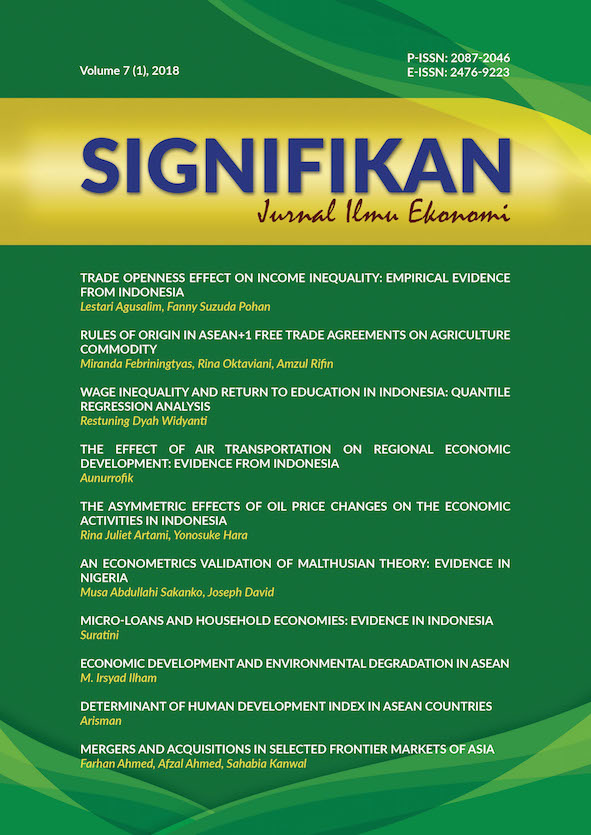Micro-Loans and Household Economies: Evidence in Indonesia
DOI:
https://doi.org/10.15408/sjie.v7i1.5954Keywords:
micro loans, household economies, asymmetric informationAbstract
Micro-loans intended to improve household economies are a fascinating subject for research because a comparative analysis of before and after taking micro-loans would result in a bias selection. Households have different prior conditions from one another, so the difference found during the study is not entirely due to receiving micro-loans. There is a risk of moral hazard risk due to asymmetric information. This research adopts the double difference (DD) fixed effects method to estimate the extent of micro-loans’ impact. Results indicate that micro-loans are significantly influencing the household economies. The impact size was relatively small that it was not apparent during regression. As an implication, micro-loans intended for productive purposes can help improve household economic conditions. Effective and sustainable monitoring and counsel can minimize the risk of moral hazard.
References
Abiola, B. (2011). Impact Analysis of microfinance in Nigeria. International Journal of Economics and Finance. Vol. 3 (4): 217-225.
Afrin, S., Nazrul, I., & Shahid, U., Ahmed. (2010). Microcredit and Rural Women Enterpreneurship Development in Bangladesh: A Multivariate Model. Journal of Business and Management. Vol. 16(1): 9-36.
AsadEjaz, & Ramzan. (2012). Microfinance and Entrepreneurship-A Case Study of Akhuwat. Interdisciplinary Journal Of Contemporary Research Business. Vol 4(7): 305-324.
Bhinadi, A. (2009). Skor Kredit dan Probabilitas Kredit Bermasalah Untuk Penyaluran Kredit Di Lembaga Keuangan Mikro Tahun 2007: Studi Kasus Bank Perkreditan Rakyat XYZ Di Provinsi Daerah Istimewa Yogyakarta (Credit Score and Default Loan Probabilitys' to Financing in Microfinance in 2007: Case Study Rural Bank XYZ in Yogyakarta Province. (Unpublished Dissertation). Yogyakarta: Universitas Gadjah Mada.
Clement, A. C., & Terande, T. J. (2012). Microcredit as a Strategy for Poverty Reduction in Makurdi Local Government Area of Benua State Nigeria. International Journal of Humanities and Social Science. Vol. 2 (Special issue-June): 179-186.
Cospetake, J. (2002). Inequality and The Polarizing Impact of Microcredit: Evidence From Zambia’s Copperbelt. Journal of International Development. Vol. 14: 743-755.
Emeka, E. J., & Noruwa, A. I. (2012). The Role and Sustainability of Microfinance Banks in Reducing Poverty and Development of Entrepreneurship in Urban and Rural Areas in Nigeria. International Journal of Business Administration. Vol 3 (3): 33-40.
Gine, X., Jakiela, P., Karlan, D., & Morduch, J. (2010). Microfinance Games. American Economi Journal: Applied Economics. Vol. 2: 60-95.
Holvoet, N. (2004). Impact of Microfinance Program on Children’s Education. Journal of Microfinance. Winter: 27-49.
Husein, J., & Jiwani, J. (2008). Microfinance: Effects of Contingent Incentive Programs on The Performance & Productivity of Loan Officers. The Journal of American Academy of Business, Chambridge. Vol. 13(2): 192-198.
Imoisi, A. I., & Opara, G. I. (2014). Microfinance and Its Impact on Poverty Allevation: A case Study of Some Micfrofinance Banks in Edo State Nigeria. American Journal of Humanities and Social Sciences. Vol. 2(1): 27-41.
Johnson, S. (2004). The Impact of Microfinance Institutions In Local Financial Markets: a Case Study from Kenya. Journal of International Development. Vol. 16(3): 501-517.
Kai, H., & Hamori, s. (2009). Microfinance and Inquality. Research in Applied Economics. Vol. 1 (1:E14): 1-11.
Kundu, A. (2011). Effectiveness of Microfinance Under SGSY Scheme to Reduce Poverty and Vulnerability of Rural Households: A Natural experiment. Jurnal of Financial Economics. Vol. IX(3): 40-55.
Leikem, K. (2012). Microfinance: a tool for Poverty Reduction? Working Paper. University of Rhode Island, 1-42.
Mallick, R. (2002). Implementing And Evaluating Microcredit in Bangladesh. Development in Practice. Vol. 12(2): 153-163.
Osotimehin, C. J., & Babatunde, H. A. (2011). Determinant of microfinance Outreach in South Western Nigeria : An empirical analysis. Institute of Interdisiplinary Business Research. Vol. 3(8): 780-797.
Robinson, M. S. (2002). Microfinance Revolution: Lessons From Indonesia. Washington: International Bank For Reconstruction and Development. World Bank.
Shahidur, K. R. (2005). Microfinance and Poverty Using Panel Data from Bangladesh. The World Bank Economic Review. Vol 19(2): 263-286.
Shirazi, N. S., & Khan, A. U. (2009). Role of Pakistan Poverty Allevation Fund’s Micro Credit in Poverty Allevation, A Case of Pakistan. Pakistan Economic and Social Review. Vol. 47(2): 215-228.
Simtowe, F., Zeller, M., & Phiri, A. (2006). Determinants of Moral Hazard in Microfinance: Empirical Evidence From Joint Liability Lending Program in Malawi. African Review of Money, Finance, and Banking. (Supplementary Issue): 5-38.
Tadeschi, G. A., & Karlan, D. (2010). Cross Sectional Impact Analaysis:Bias From Dropouts. Perspectives on Global Development and Technology. Vol. 9: 270-291.
Waheed, S. (2009). Does Rural Micro Credit Improve Well-Being Of Borrowers In The Punjab (Pakistan). Pakistan Economic and Social Review. Vol. 47(1:summer): 31-47.
Waheed, S. (Summer, 2009). Does Rural Micro Credit Improve Well-Being Of Borrowers In The Punjab (Pakistan. Pakistan Economic and Social Review. Vol. 47(1): 31-47.
Weele, K. D. V., & Weele, T. J. V. (2007). Microfinance impact Assesment: evidence From a development Program in Honduras. Saving and Development. Vol. 31(2): 161-192.

